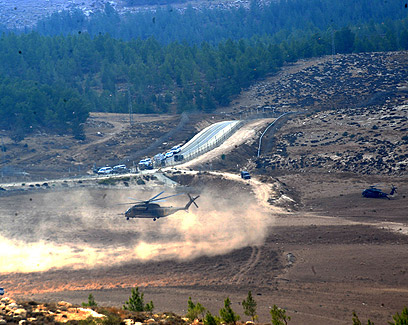Published on Oct 6, 2012 by idfnadesk
An unmanned aerial vehicle (UAV) was identified penetrating Israeli airspace this morning, and was intercepted by the IAF at approximately 10:00 AM.
IDF soldiers are currently searching the area where the drone was downed, in open areas in the northern Negev, to locate and identify the drone.
IDF soldiers are currently searching the area where the drone was downed, in open areas in the northern Negev, to locate and identify the drone.
__________________
Downed drone: Iran testing Israel's capabilities
Unmanned aircraft shot down by F-16 jets in south Israel was apparently launched from Lebanon by Hezbollah, or perhaps even by the Iranians themselves
Ron Ben-Yishai
A few hours after two fighter jets shot down a small unmanned aircraft that penetrated Israeli airspace in the south Saturday morning, it is safe to say that an element operating in Lebanonunder the auspices of Iran and with its support, apparentlyHezbollah, activated the drone. The drone itself, which was downed in the south Mount Hebron area, was apparently made in Iran.
Related articles:
Hezbollah's drones have infiltrated Israeli airspace in the past, from the north, but their activation did not require any navigation system. The unmanned aerial vehicle (UAV) that infiltrated Israel on Saturday did require such a system. The incident showed that the Air Force has the ability to detect and intercept drones at any stage of their flight.
The drone was apparently launched by Iran or one of its allies to test the IDF's detection and interception capabilities, and perhaps even to search for specific targets in south Israel. The drone apparently began its flight in Lebanon and then headed in the direction of Gaza's coastline after flying over the Mediterranean Sea. This route was chosen not only because it utilized the depth of the sea's airspace, but also because Israeli UAVs regularly hover above Gaza.
There is no doubt that the operation is indicative of a high level of sophistication of the drone's operators, who are apparently Hezbollah terrorists, and also of their plans to perhaps use similar Iranian-made aircraft in the future to destroy targets inside Israel. It is also clear that Hezbollah chose such a long route so that it would not be accused of sending the drone and risk Israeli retaliation.  IDF choppers in area where drone was intercepted (Photo: Haim Horenstein) In other words, Hezbollah tried to conceal the fact that it had sent the drone by selecting a long route that passed through the Mediterranean Sea. It wanted the drone to enter Israel near Gaza, perhaps in an attempt to place the blame on Hamas, which is currently considered hostile to elements that are loyal to Iran. Hezbollah has launched drones into Israel a number of times in the past. Before the Second Lebanon War two Iranian-made "Abibal" drones successfully infiltrated Israel, and during the war itself Hezbollah sent drones through the sea, perhaps in an attempt to blow them up in Israeli communities. These attempts failed, and in at least one incident a drone launched by Hezbollah was shot down by an F-16 over the sea.
Iran recently announced that it had developed small unmanned aircraft and cruise missiles with a range of hundreds and maybe even thousands of kilometers. The drone that was intercepted earlier in the day may have been one of the new models manufactured by Iran. Syria is also capable of operating drones from a long distance.
As far as Israel is concerned, Saturday's incident calls for increased alertness and preparations to thwart such infiltration attempts in the future. If it turns out that the drone was Iranian and was launched by Iran or Hezbollah, Israel would have to consider its response to such a blatant violation of its airspace. In light of the successful interception and the explosive situation in the Middle East, Israel may decide to act with restraint and not respond at all. It will certainly want to avoid a massive response that may ignite the entire region. Israel will also examine the possibility that the drone was supposed to take photographs of areas in south Israel.
|
